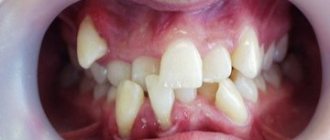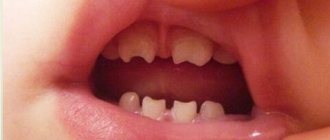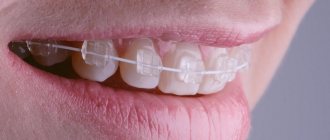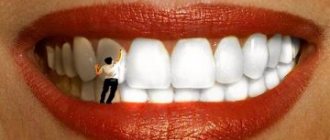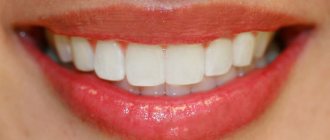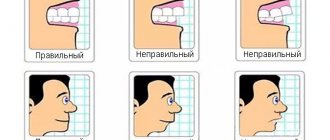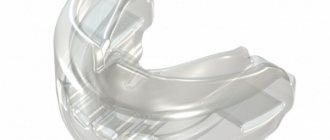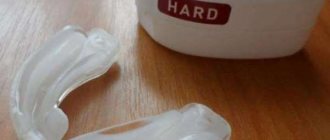The presence of milk teeth in adults cannot be attributed to the realm of fantasy or humor. This phenomenon can sometimes be encountered in dental practice. What contributes to the fact that a baby tooth can be preserved in adults and what to do with such a childhood “relic”?
Echo of childhood
Most people believe that baby teeth are closely associated with a touching and carefree childhood. It’s not for nothing that James Barry, a Scottish writer, in his fairy tale about Peter Pan - a boy who wants to always be young and not grow up - specifically describes that there were many milk pearl teeth in his mouth, and none of them had fallen out yet. Replacing baby teeth with permanent ones can be considered the same step into adulthood as the first room at school and the first two.
Teeth begin to change at about 5-6 years of age, and this process ends at about 12-14 years. Currently, according to the observations of many doctors, the replacement of baby teeth with permanent ones occurs in younger children than happened in past decades. But it also happens that baby teeth can be preserved in adults. Such cases can be encountered at 20, 30, and sometimes at 50 years of age. Why does this happen and what to do in such a situation?
What is retention
Retention is a delay in the growth of baby or molar teeth. With this pathology, the tooth may erupt, but not completely, but can be barely visible above the gum, and it can also grow only under the gum, not showing out at all. First of all, this disease affects the second premolars and third molars located on the lower jaw, as well as the canines of the upper jaw. Maxillary canine impaction is much more common in women. This pathology can occur on one side of the jaw or on both sides at once. Canine impaction in the lower jaw is a very rare occurrence. Impaction of primary teeth is also extremely rare. Such disorders in children can be caused by an acute lack of vitamins in the body or serious pathologies during teething. Impaction of primary teeth can be caused by severe rickets.
How many teeth should a child have before 1 year of age?
Initial signs of teething, as a rule, appear at six months of age: active salivation, inflammation of the gums, refusal to eat. During this period, the lower incisors begin to break through, which is accompanied by swelling, diathesis, tearfulness, drowsiness, runny nose, cough, fever and even vomiting, diarrhea or constipation. Symptoms disappear 3-7 days after the exacerbation.
Eight- and nine-month-old babies grow up to six teeth. As a rule, the lower incisors are already fully formed, and the upper ones are just beginning to develop. The child learns to chew and bite food independently.
At 10-11 months, as a rule, the incisors of both rows are already formed in the mouth, and adjacent teeth are also breaking through. At this time, after eating food, it is recommended to give the baby water. To avoid caries, you should not accustom him to sweets. Maintain hygiene and cleanliness of the pacifier and spoon from which you feed your baby. If a child’s lower front tooth does not grow at this age, there is no need to panic - experts define this situation as standard and not requiring intervention. To get rid of false suspicions, you can go for a medical examination. Our VTV clinic is always happy to help with any dental problem.
Types of pathology
Teeth eruption disorders can be of two types: complete and partial, and the tooth, respectively, impacted and semi-impacted. The last type means that the tooth has erupted a little, i.e. visually observed above the gum. The impacted tooth is completely hidden by the gum and is not accessible to palpation. According to the depth of their occurrence, such teeth can be tissue embedded (the tooth is located in the gum tissue) or bone embedded (lies in the jaw bone). Such teeth can be located:
- Angularly, i.e. at an angle.
- Vertical.
- Horizontally.
Sometimes there are so-called reverse impacted teeth, most often these are the lower eighth teeth. In such teeth, the upper part is turned towards the jaw, and the roots are turned towards the alveolar edge. There are also symmetrical, unilateral or bilateral tooth retention.
Symptoms of dystopia
Symptoms of dental dystopia are most often visual and easily noticeable. It is enough to look at the position of all the elements of the dentition to see that some of them are in the wrong places or are simply growing unevenly. Other symptoms:
- there is no tooth in the bite, and the period of eruption has already passed;
- inflammation and pain are felt at the site of the wisdom tooth;
- The wisdom tooth did not appear on time
It is interesting that in a number of cases there is no wisdom tooth at all - it does not form and does not erupt. Dentists call this option a variation of the norm.
Why does a canine or molar not appear?
The concept of retention refers to the anatomical specificity of the jaw or an anomaly in the formation of the tooth germ. Experts believe that this pathology arose in modern society as a result of eating too soft food, i.e. people have practically stopped chewing solid food. Other reasons why retention may occur:
- improper feeding of the child;
- reduced immunity associated with exposure to infections;
- delay in replacing milk teeth with molars;
- the presence of supernumerary teeth that prevent the eruption of a permanent tooth;
- incorrect location of the permanent tooth germ in the jaw bone. With this pathology, the crown of the tooth is directed towards the root of the adjacent tooth, thereby preventing its appearance and the eruption of neighboring teeth;
- bad heredity.
Conclusions. Expert advice
Dystopia is the incorrect position of a tooth in the jaw: its displacement forward or backward, down or up, as well as rotation around its axis or tilt. The appearance of such an anomaly is associated both with hereditary factors and with bad habits or mechanical damage to the jaw. The sooner dystopia is detected, the easier it is to cure. In adults, the wisdom tooth most often found to be dystopic is the third molar, because there may simply not be enough space in the jaw for it to erupt.
The consequences of such anomalies include general malocclusion, frequent inflammatory diseases, impaired chewing function, and much more. Depending on the complexity of the case, dystopia is treated either by tooth extraction or with the help of braces. If the decision is made to remove it, it is important to carry out the operation carefully and correctly. If treatment is started on time, the prognosis for the disease is positive.
The main symptoms of the pathology
Retention in dentistry is quite common, and there are some signs by which this pathology can be detected:
- pain in the gums, radiating to the ear and temporal part;
- regular injury to the same place in the oral mucosa;
- numbness and swelling;
- painful sensations when opening the mouth and while chewing food;
- mobility or displacement of teeth;
- deterioration of general health due to the inflammatory process (fever, weakness, chills, etc.);
- the appearance of a cyst or abscess.
How can you avoid age-related changes with the help of modern dentistry?
Even though our teeth age along with the rest of our bodies over the years, this does not mean that it is impossible to maintain an attractive and healthy smile in old age. Rule number one is good daily hygiene. Rule number two is regular preventive visits to the dentist. Professional cleaning will help remove hard plaque and prevent the development of caries, and the remineralization procedure improves the condition of the enamel. Laser and physical therapy are now actively used to strengthen gums, therefore, if you have problems with periodontal disease, it is recommended not only to visit a specialized specialist, but also to monitor the health of your gums at home. Rule number three is a balanced and healthy diet, coupled with taking vitamin complexes. This will help not only the teeth and oral cavity, but also other systems of the body.
Publisher: Expert magazine about dentistry Startsmile.ru
Author of the material: Yaroslav Ikonnikov
Elimination of anomaly
Treatment of retention is a rather complex process that requires qualified assistance from dentists of several specializations. Treatment is selected individually for each patient and depends on the clinical picture of the oral cavity. The first question that a dentist needs to decide is whether to remove or save a diseased tooth. There are several treatment methods, most often this is a surgical intervention in which a specialist cuts the gingival hood so that nothing prevents the tooth from erupting outward. Surgical procedures of this kind are used in situations where the tooth grows correctly and does not interfere with neighboring teeth. In other cases, most often, the tooth is removed. Removing an impacted tooth is a rather difficult operation. The procedure is carried out under local anesthesia, after which the gum is cut, and the specialist uses a bur to create access to the tooth, after which it is completely removed. Then a special medicine is placed into the tooth socket. If necessary, sutures are applied and removed ten days after the procedure. Swelling may occur after removal of an impacted tooth. Most often, after removing such a tooth, the doctor prescribes antibiotics and painkillers. Also, the patient, for the first few days, needs to stop eating solid foods, hot and cold foods and drinks.
If the tooth has not grown, we will pull it out
IF THE TOOTH HAS NOT GROWN, WE WILL PULL IT OUT
An orthodontist is a doctor who is especially popular today not only among children, but also among adults. It is relatively easy for children to straighten their teeth while the jaw bones are still young and pliable. But in adults, bite treatment is no longer a problem. Most often, orthodontic treatment is required when a person decides to undergo prosthetics. He comes, as expected, to the orthopedist, and he is immediately referred to the orthodontist. There are several reasons for this,” says medical orthodontist Roman Labzin.
One of the reasons is that there is not enough space in the mouth for dentures, which means that the dentition needs to be moved apart. Crowded teeth also require correction of their position. In general, an orthodontist is the first doctor who prepares the mouth for prosthetics.
Or could it happen that after visiting the orthodontist, you won’t need prosthetics? Will all teeth fall into place or will they successfully take someone else’s teeth?
Through orthodontic treatment, it is actually possible to replace missing teeth and do without prosthetics. For example, a patient once had his lower sixth teeth removed. He is faced with a choice - either to install an implant at great expense and cover it with a crown, or... to move nearby teeth. Typically, such people have problems with their bite and teeth alignment. By correcting the bite, I can close the gap of the extracted tooth - that is, kill two birds with one stone.
Some kind of “epidemic” has begun with malocclusions - you walk around the city and see almost every second person has braces on their teeth, and, surprisingly, in adults.
And this is not surprising. It is adults who most often turn to the orthodontist due to malocclusion. This problem actually occurs in every second person. The bad habits that adults instill in children, starting from infancy, play a detrimental role in this. For example, the habit of using a pacifier. I had a girl who did not take the pacifier out of her mouth until she was six years old. And as they get older, children begin to eat incorrectly—swallowing food, chewing it poorly. Apparently, looking at adults who are always in a hurry somewhere. Due to products that are already sold in a “chewed” state - yoghurts, muesli, baby purees, children and teenagers no longer need to chew, therefore teeth do not grow, jaws do not change and an anomaly is formed. Add here pathologies from the nasal cavity - adenoids, which in our humid climate develop in almost all children, and you get another reason for improper development of the jaw.
How exactly do adenoids affect teeth?
Due to adenoids, nasal breathing is impaired, and the child constantly breathes through the mouth. His lower jaw droops, and his upper jaw becomes very narrow, so there is not enough space for all his teeth, and they grow, overlapping each other. There are many reasons for the development of malocclusion. The most important function of teeth is chewing, so chewing is essential for both children and adults.
And if an adult has nothing to chew, is it not harmful for him to go without teeth for years?
Of course, it is harmful, now for the gastrointestinal tract, since undigested food causes gastritis and ulcers. In addition, ten years after losing teeth, such deformations will occur in the oral cavity that it will be very difficult to restore a normal bite. Rational prosthetics must be done on time.
How long after root removal do I have to wait before getting prosthetics?
It is better to do this within six months, or at most, up to a year.
How does your bite change with age?
First of all, the depth of the bite changes. While eating, the teeth rub against each other and gradually wear down and decrease in height. Such physiological wear of teeth over the years can significantly shorten them and lead to periodontitis. When this process occurs too quickly, pathological tooth wear develops, which causes a deep bite. A deep bite is a jaw condition in which the upper teeth overlap the lower teeth by more than one-third of the incisor crowns.
So, you should nibble on carrots while you’re young, and switch to more gentle food as you get older?
Of course, after 50 years it is better to take care of your teeth. Moreover, if the teeth wear evenly, the orthodontist will not help. Then it is better to contact an orthopedist, who can prevent further tooth wear by placing crowns on them.
What other bite pathologies are there?
Medial bite – when the lower jaw protrudes and the lower teeth protrude above the upper teeth. This pathology does not give a very aesthetic appearance to the face, but it is most often congenital and genetically inherited. Orthodontic treatment will not help here; maxillofacial surgery is necessary.
Changing the bite does not have a very good effect on appearance...
Yes, a decrease in bite height due to tooth wear leads to a visual reduction in the lower third of the face and a deepening of the nasolabial fold. Of course, this ages the face. Therefore, dental prosthetics and, accordingly, orthodontic treatment should be carried out in due time.
Until what age can a bite be cured?
One client I gave braces to was 58 years old. She had an impacted canine - a tooth that had formed at one time, but never erupted. Many years ago, the dentist apparently did not notice it, and when her baby tooth fell out, he gave her a denture, which she wore all her life. And we carried out orthodontic treatment and pulled this canine out. Now she has her own real tooth.
How often do such situations occur?
I have several patients with impacted fangs, some have one tooth left in the bone, others have both. Quite often the upper incisors fail to grow in, this happens for various reasons. One of the most common is the removal of baby teeth in early childhood. It very rarely happens the other way around. Milk teeth are retained until a person is 25 years of age or older. And the permanent tooth not only does not grow, but is completely absent from the bone. Then you have to place an implant and also carry out orthodontic treatment. Braces are the most popular type of correction among people. And when they do not help, then you have to resort to other structures, including removable ones. There are many treatment methods, of which I choose only those that are suitable for a particular person with his bite and problems.
What are the main indications for treatment by an orthodontist?
The main indication is teeth that are incorrectly positioned or grown in the wrong place. Of course, a greatly altered bite, which we have already talked about. Small changes in the bite are difficult for a person to determine on their own, so it would not hurt for every person to come for a consultation with an orthopedist at least once.
You can go to the orthodontics section at the multidisciplinary clinic “Panorama Med” here .
To make an appointment with an orthodontist, call: +7 (812) 244-90-10 and 8 (812) 970-00-70
How is the treatment carried out?
When choosing treatment tactics, the dentist takes into account:
- how old is the patient;
- how long ago the permanent unit emerged;
- how much the molar crown appeared;
- what condition is the milk unit in;
- does the child have any complaints;
- general condition of the dentition;
- the patient has a predisposition to dental anomalies.
After conducting an in-person examination, the dentist decides whether to pull out the interfering tooth or leave it and wait until its roots resolve on their own. In the first case, local anesthesia is administered and removal is carried out; in the second, the doctor tells you when the baby needs to come for a second examination. Thus, if you deal with the problem of a “shark” smile in a timely manner, it will not cause negative consequences.
